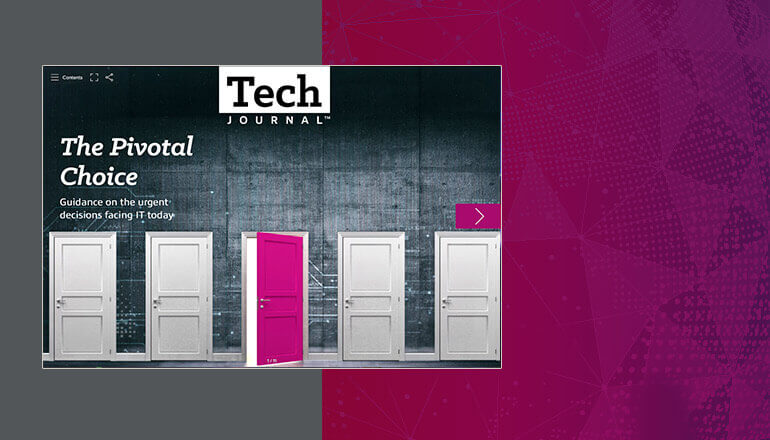Tech Journal No Flash in the Pan
By Insight Editor / 18 Sep 2019 / Topics: Storage

All-flash storage is now affordable for all.
We know that technology almost always gets better, faster and cheaper over time. And in the world of enterprise storage, it’s absolutely true.
Organizations around the world are benefiting from exponential strides in storage technology. Specifically, all-flash arrays have become the de facto standard for performance, reliability and price.
If you are considering replacing performance disks or if you need a cost-effective flash solution, there are some important things that you should keep in mind before you buy.
First, and this is perhaps the biggest myth about flash: It is not true that all-flash arrays are more expensive than performance disk (SAS 10K) drive-based systems. When you factor in data reduction and storage efficiency capabilities, flash can actually be less expensive per gigabyte (GB) than disk. Plus, all-flash arrays will substantially save on OpEx and CapEx, including expenses related to floor space, rack space, power and cooling, server farms, software licensing and operational staff.
In fact, studies show that all-flash storage pays for itself in just five to six months on average, the result of dramatic improvements in total cost of ownership (TCO).
In the early days of enterprise flash, high costs per GB usually meant that only a few carefully chosen workloads with ultra-high-performance needs could justify the added cost of flash. Flash technology has since matured, and flash costs have decreased significantly.
Another benefit of moving to flash is that the old way is simply not working. With recent technology shifts, vendors stopped any further developments in SAS 10K. If you’re running a traditional storage architecture, you already know this. And it’s not the only problem. Many IT teams struggle to meet performance service level agreements (SLAs) with traditional storage.
You might be spending increasing amounts of time on trying to tune performance, a problem that has been made more difficult by new applications with different I/O profiles and performance demands. Whatever the reason, there has never been a better time to consider switching to all-flash storage.
So, when you’re looking for all-flash storage, consider these factors: capacity, performance, data availability and protection, simplicity and support.

1. Capacity
We know that it’s difficult to project future needs, but don’t buy more capacity than you need. It leads to unnecessary up-front costs and maintenance headaches. It’s better to fully document your requirements: Understand the raw capacity, effective capacity and data reduction ratios with storage efficiency technologies like deduplication, compression and compaction.
2. Performance
Today’s enterprise must be fast, global, mobile, social, digital and on-demand, all at once and all the time. These simultaneous needs now require business as usual to operate more in the realm of high performance. Many next-generation applications will benefit from the high performance and low latency of flash storage.
3. Data availability and protection
Flash drives are inherently more reliable than disk, but they can fail, so standard forms of data protection still apply. Most all-flash storage systems incorporate some form of RAID, which enables quick rebuilds and limits exposure to a second failure. To account for failures that result in unplanned downtime, it’s always good to choose a vendor with a well-designed architecture and a proven track record of reliability.
Finally, no matter how reliable an architecture you choose, you still need backup and a plan for disaster recovery (DR). Modern storage architectures should integrate snapshot and replication features that make backup, recovery and DR functions faster and more efficient.
4. Simplicity
Savvy IT organizations are updating to smart all-flash storage to simplify their management. With flash, they can now:
- Provision storage in minutes, from power-on to serving data
- Manage file and block data on a single system to improve the productivity of their IT teams
- Automatically tier cold data or back up to any public cloud to reduce overall storage costs
5. Support
IT infrastructure is supposed to be a means to an end, not an end in itself. The continuous monitoring, management and maintenance that are required with traditional storage systems, however, might be keeping your IT team from focusing enough attention on the applications and services that move your business forward.
Why Flash?
It’s simple. You can provision storage in just minutes and easily manage multiple workloads from a single system.
It’s smart. With its built-in efficiency technologies, you get more capacity at a lower cost.
It’s secure. You'll prevent data loss and safeguard data from internal and external threats.
Improved Reliability
Some IT professionals continue to be concerned about the durability of flash media, or flash “wear-out,” even though a wealth of real-world data demonstrates that SSDs are extremely reliable. The good news is that most vendors are so confident about the long-term reliability of their all-flash systems that they’re happy to provide you with an extended warranty. Other options, such as free controller upgrades, might also be available if you are willing to commit to a long-term service contract.
Is your network fast enough to keep up with the speed of all-flash storage?
Even a handful of SSDs has the potential to saturate typical 8Gb and 16Gb Fibre Channel SANs or 10 Gigabit Ethernet networks. When you increase the speed of an all-flash storage system, expect the network bandwidth requirement for that storage system to increase at the same rate. Unless you plan ahead, network bottlenecks are the inevitable result. Look for all-flash storage that supports multiple network connections and the latest high-speed network options, including 32Gb Fibre Channel, 100 Gigabit Ethernet and NVMe over Fabrics (Ethernet, Fibre Channel and InfiniBand).
Data-driven business
Empower your workforce to access quick analytics and propel new growth with NetApp® data solutions, available from Insight.
Learn more
Related articles
Narrow your topic:
ABOUT NETAPP
NetApp® is the data authority for hybrid cloud. We provide a full range of hybrid cloud data services that simplify management of applications and data across cloud and on-premises environments to accelerate digital transformation. Together with our partners, we empower global organizations to unleash the full potential of their data to expand customer touchpoints, foster greater innovation, and optimize their operations. For more information, visit www.netapp.com. #DataDriven
NETAPP, the NETAPP logo, and the marks listed at http://www.netapp.com/TM are trademarks of NetApp, Inc. Other company and product names may be trademarks of their respective owners.










